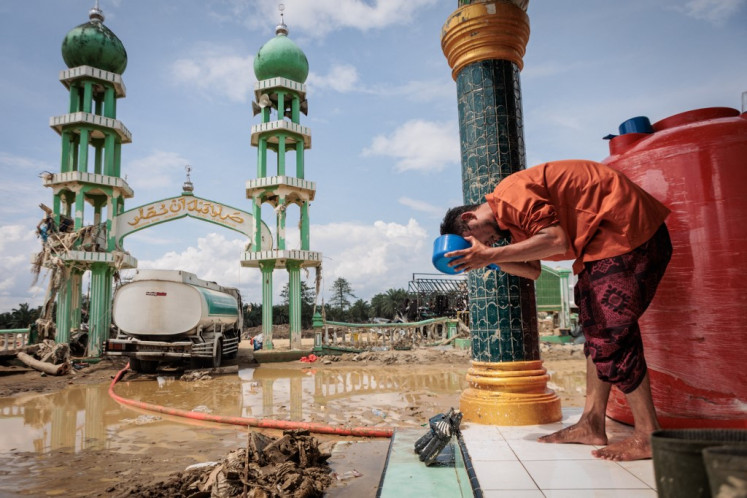Popular Reads
Top Results
Can't find what you're looking for?
View all search resultsPopular Reads
Top Results
Can't find what you're looking for?
View all search results'No Country': Common borders in contemporary art
Exploring the contemporary: Installation shot of âNo Country: Contemporary Art for South and Southeast Asiaâ exhibition at the Centre for Contemporary Art, Singapore
Change text size
Gift Premium Articles
to Anyone
E
span class="caption" style="width: 597px;">Exploring the contemporary: Installation shot of 'No Country: Contemporary Art for South and Southeast Asia' exhibition at the Centre for Contemporary Art, Singapore. (Courtesy of Solomon R.G)
A contemporary art exhibition is exploring the intertwined histories of nations in South and Southeast Asia and the dynamic relations that challenge typical definitions of the regions.
The 'No Country: Contemporary Art for South and Southeast Asia' exhibition opened on May 10 and runs until July 10 at the Centre for Contemporary Art (CCA) in Singapore.
It is the inaugural touring exhibition of the Guggenheim UBS MAP Global Art Initiative, a multi-year project exploring contemporary art in three regions, namely, South and Southeast Asia, Latin America and the Middle East and North Africa.
For the inaugural presentation, the project showcased works by 16 inventive artists and collectives from countries across the regions, including Bangladesh, India, Indonesia, Malaysia, the Philippines, Singapore and Thailand.
Through their works, the artists explored four themes: reflection and encounter; intersections and dualities; diversities and divisions; and the desire for unity and community.
Prior to the exhibition in Singapore, the artworks had been showcased at the Solomon R. Guggenheim Museum in New York and at the Asia Society Hong Kong Center.
'If I were to put the exhibition in one word, it is 'representation' ' of how we project, absorb, perceive, believe, desire, defend and redefine who we are. 'No Country' proposes the reevaluation of the region and its countries, through cultural relationships, influences, affinities and negotiations,' exhibition curator June Yap said.
'While the exhibition discusses representation, it also discusses the impossibility of that. That's how we have the paradoxical title 'No Country' in discussing how these borders exist, how they are defined and what we do with them.'
Yap, who has been working as an independent curator with artists throughout these regions since 2008, said that through the reflections by the artists, the exhibition offered the possibility of considering and recalibrating an understanding of communities and cultures in the regions as greater than their political and geographic boundaries.
Volcanic: olcanic Ash Series 4 by Arin Dwihartanto Sunaryo. (Courtesy of Solomon R.G)
'In doing so, these artworks reinstate art practice as political life, as cultural negotiation rather than representation, and not merely the consequence of a past, but forewarning for a future,' she said.
In 'No Country', Indonesia is represented by two established artists: Arin Dwihartanto Sunaryo and Reza 'Asung' Afisina.
At the CCA gallery, Arin put up his 2012 work titled Volcanic Ash Series #4 ' a painting made of volcanic ash and pigmented resin on a wide panel. In the work, Arin combined the fluid material of resin with ash gathered from the 2010 eruption of Mount Merapi in Yogyakarta.
On the other side of the gallery, Asung's 2001 work, titled What..., was being looped on an LCD TV screen. In this video performance, Asung recites biblical verses from the Book of Luke about Jesus' warnings against hypocrisy and the importance of truth and confession, while repeatedly slapping his own face.
'Although I'm a Muslim, for me the verses are really interesting and poetic. I think it says that we can find truth in many different texts of religions,' Asung told The Jakarta Post.
Yap said that Arin and Asung were artists she was interested in contributing to widening the exhibition's themes conversation.
'We're really looking at what their works are trying to say and how they open a broader dialog. It's also nice to know what the younger generation artists of the region are thinking about,' Yap said.
Throughout its run in Singapore, 'No Country' will be accompanied by a wide range of artist lectures, tours, performances and online initiatives adapted specifically for the presentation in Singapore, including talks by Sheela Gowda, Navin Rawanchaikul and Norberto Roldan ' all are artist participating in the exhibition ' during the opening weekend.
The Guggenheim UBS MAP Global Art Initiative, which focuses on Latin America, will open its exhibition 'Under the Same Sun' at the Guggenheim Museum in New York on June 13, and will also tour to two other major international cities.












